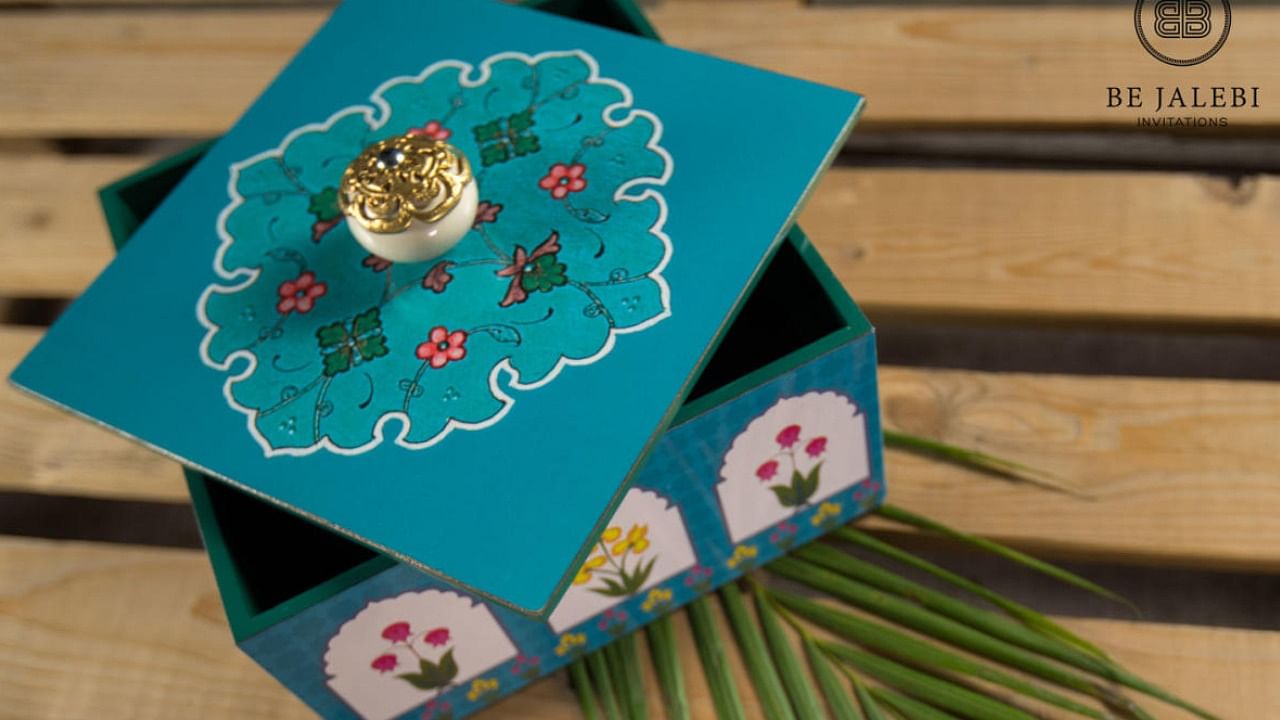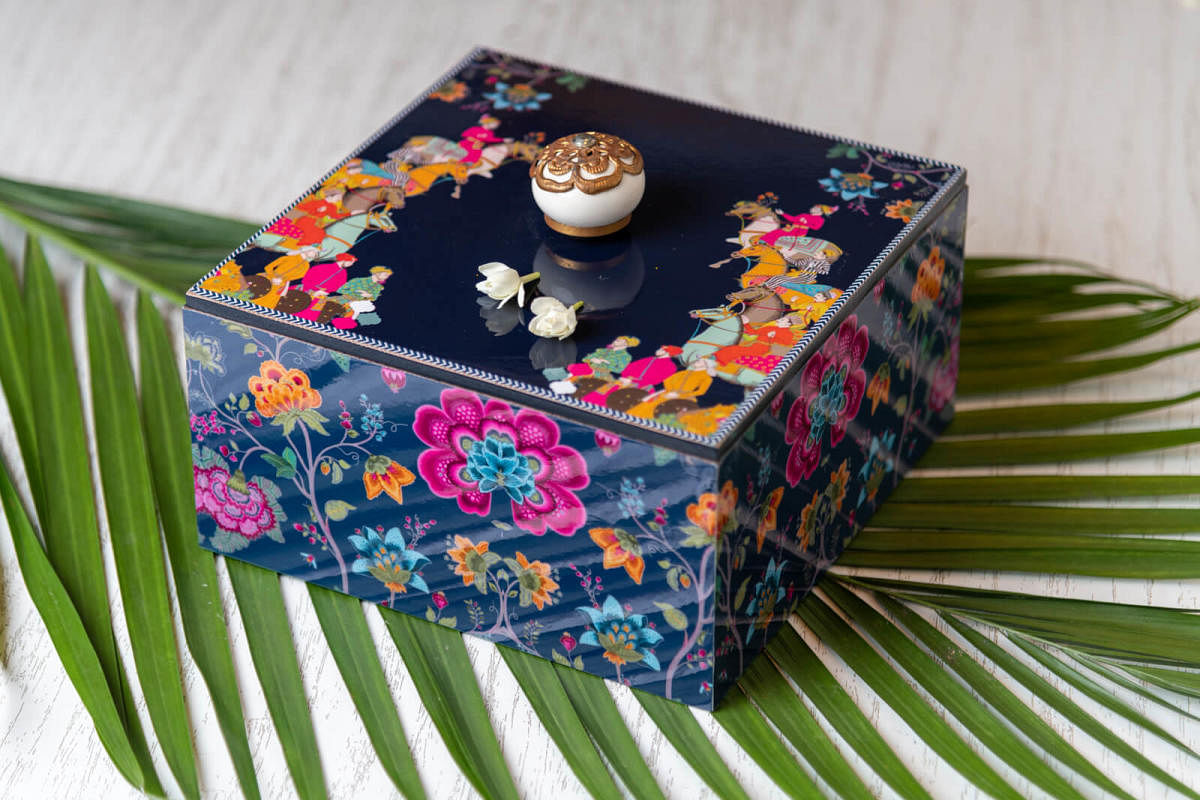

Traditional styles of wedding invites seem to be archaic now. Invites now include a preview of the wedding theme, feature the couple’s stories, and details about the events and vary from simple to grand.
Story decides design
Based out of Mumbai, Expressing Ideas custom designs their wedding invites on the story of the couple. “We find out how they met and create a logo for them, which kickstarts the designing process,” says founder Masumi Dhawan.
Venue is an important aspect as well, she says. “A Goa wedding card will have a tropical vibe, and Jaipur will be royal.”
Customised feel
Their most popular designs are customised illustrations (meaning, visual representations of concepts, moods, brand identity, and specific messaging). “These have a watercolour art feel,” says Masumi. They have also made designs where they have incorporated the pattern from the bride and groom’s outfits.
They have gone down the quirky route for customers before. “We have made cards that look like calendars. We also made a card that had moveable parts, and each time something moved, it revealed new information,” she says.
Masumi recalls a recent design where they customised every insert of the card to provide extra information, according to the bride’s outfit, venue, and decor. “The reception card had a ballroom vibe with a chandelier. Each insert took about a month to make because of its detailing,” she adds.
Boxes and e-invites
Moving away from traditional invites, Be Jalebi from Delhi, makes cards that can be used multiple times — like box invites. Designer and owner Tanvi Gupta says, “Boxes available in the market are either too expensive or of bad quality. We wanted to provide boxes with amazing design and quality. We can design as few as 50 boxes for an event.” They create wooden boxes with prints that have many uses. “It can be used as a cutlery stand, utility box, and makeup box,” she says.
Over the last two years, there is a shift towards e-invites. “Many come with pictures from Google and Pinterest and if it matches our aesthetics, we move forward,” says Tanvi.
Trays with invites and sweets are another hot pick. They choose boxes and trays as “people now want things that can be used again. They want something sustainable.”
They also make the same boxes in cardboard, which are cheaper. “We use many decorative methods like foiling, to make a simple box look fancy. Our Taj collection is a bestseller. We can do the same print on a Rs 500 box, Rs 800 box and a Rs 1,700 tray as well,” says Tanvi.
Floral and acrylic
Mumbai-based Rolex Cards use floral designs, acrylic cards, and pastel colours individually and as a combination in its card designs.
Some of their latest designs are floral prints, floral on acrylic, 3D pop-up, laser cut designs, cloth, and box-style invites, says owner Rohit Jain.
The wooden boxes saw a rise during Covid and are still in demand. “There were pandemic regulations of only 50 people being allowed to gather. These boxes with sweets were sent to all the people they could not invite to the wedding,” he says.
Talking about the demand for eco-friendly invites, he says, “There was a seed paper card back in 2018, where the invite could be sowed and watered down to grow into a plant. But printing on this paper was not easy, the text was always crooked. This paper was also expensive. It was a rage for about six months, after which we stopped printing it.”
Rohit is open to innovative personalisations. “We once made a card for aviation buffs. It was a normal card with a laser-cut plane on wood with initials that hung by a thread at the bottom,” says Rohit.
Animated invites
Pune-based Mitali Bhandari makes animated invites under her brand The Murphy Studio. It specialises in custom designs to create branding for the wedding.
“We create a small logo, which is used on everything from the pillow cover to napkins, so as soon as the guest enters the wedding venue, they know everything is connected,” says Mitali. She recalls how a bride wanted the wedding logo of a swan, as she would be wearing a mangalsutra (an auspicious necklace tied around a bride’s neck) with a swan on it.
Mitali says digital invites are their forte. “I don’t mean PDFs but animated videos with great music to create the mood of the event. If someone has a destination wedding, like in Rajasthan, we show royal Rajasthani doors opening up, or elephants that are showering flowers on the guests.”
People now want wardrobe planners as part of their invites. Since destination weddings are trending, people add these planners to include a list of events and their themes. “We send illustrations and graphics that support these events. Like if a ‘sangeet’ is themed ‘glitz and glamour’, it will have a man in a tuxedo and a woman in a gown, so the guests know what to come in,” says Mitali.
The sustainability and eco-friendly aspect of digital invites is an added advantage.
Designing process
The designing process, which also involves detailed discussions with the client, takes about three to four weeks. Printing takes an additional two to three weeks. Animated e-invites take two to three months, and box invites take a month.
Price range
Box invites: Rs 550- Rs 1,500
Digitally animated: Rs 45,000-Rs 50,000
Printed on paper: Rs 500-Rs 50,000